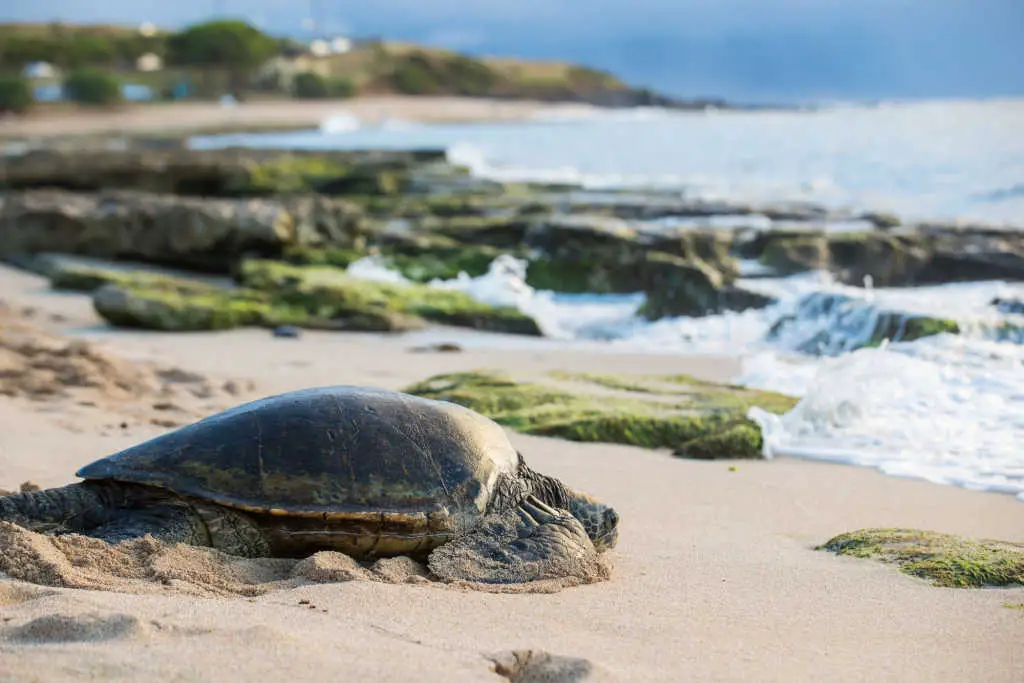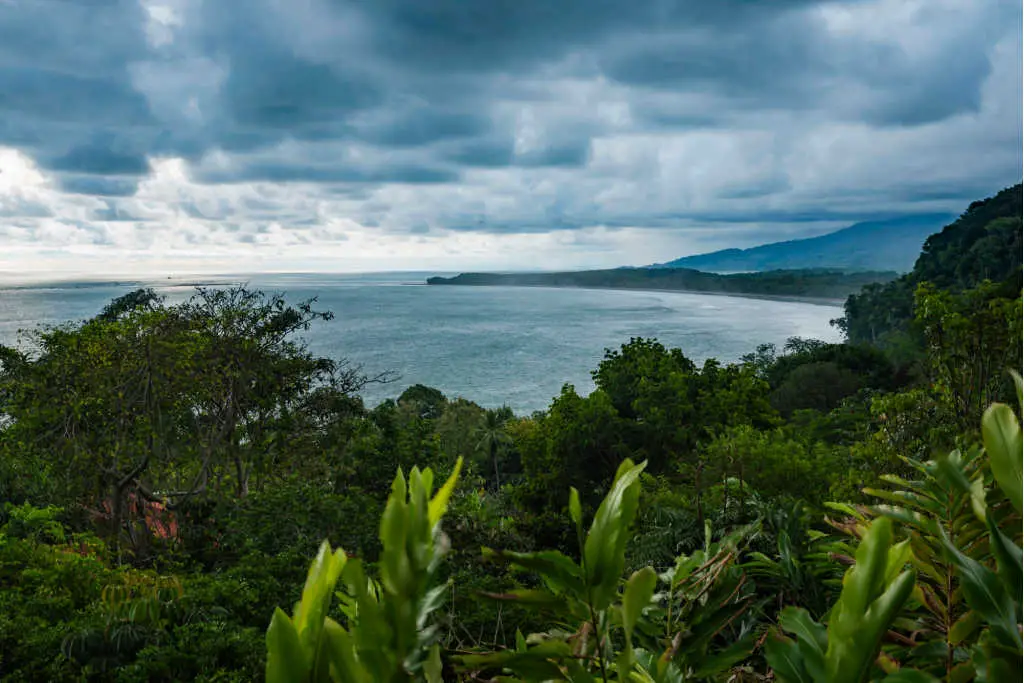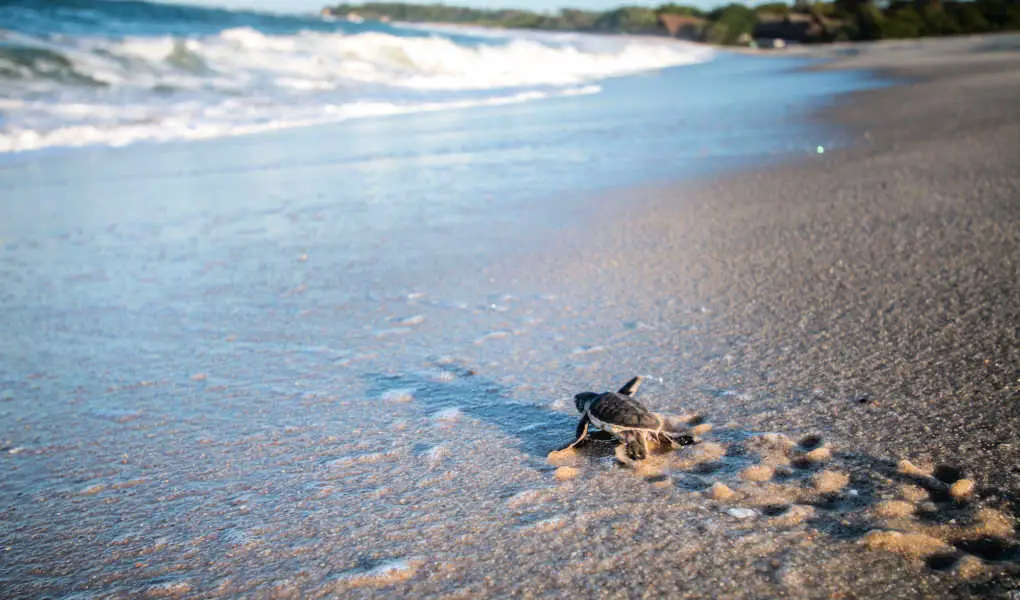Panama, with its long coastlines, is one of the most important nesting sites for many species of sea turtles, including the great green turtle (Chelonia mydas). These majestic creatures play a key role in marine ecosystems and are the object of close attention from scientists and conservationists.
Lifestyle
This kind of sea turtle lives in tropical and subtropical waters of all oceans, preferring shallow waters and coral reefs. Despite its name, the green turtle’s shell color can range from olive green to dark brown, and the characteristic green color is due to fatty deposits under the shell.
Green turtles have a large oval shell, which serves as reliable protection from predators. Adults can reach a length of 1.5 meters and weigh more than 300 kilograms. These turtles are excellent swimmers, capable of getting a significant speed underwater.
Green turtles’ diet mainly consists of seagrasses and algae, which makes them one of the few large marine animals that feed on plant food. Young turtles are more omnivorous and can eat small invertebrates. This is due to the active growth of the skeletal system and shell, which affects the body’s need for calcium and other minerals.
Life Cycle
Green turtles lead a solitary lifestyle, gathering together only during breeding. Females lay eggs on sandy beaches, burying the clutch deep in the warm sand.
An interesting fact is that female turtles often return to the same beaches where they were born. This process, called philopatry, is a great example of the instinct and navigational skills of these amazing animals.

After about two months of incubation, the eggs hatch into baby turtles. They instinctively head towards the light, which usually comes from the moon, reflecting off the ocean surface. Sometimes, artificial lighting from coastal cities leads them astray, and many baby turtles die before reaching the water.
After laying their eggs, the adult turtles return to the sea, and the baby turtles hatch on their own and set out on their first voyage. The hatchlings spend their first years of life in the open ocean, feeding on small organisms such as jellyfish. They then migrate to areas rich in marine vegetation, where they become adults.
Importance for the Ecosystem
Green turtles play an important role in marine ecosystems. By feeding on sea grasses, they help maintain the balance of marine communities. In addition, green turtles are an important element of the food chain and serve as food for other marine animals.
The large green turtle is an amazing creature that plays an important role in the marine ecosystem. Preserving the population of marine life is the task of not only scientists and conservationists but also of each person. Each of us can contribute to this noble cause by refusing to use plastic products, supporting eco-friendly tourism, and spreading information about the importance of nature conservation.
Protection and Conservation of the Species
Unfortunately, green turtle populations are endangered in many regions. The main reasons for the decline in the number of these animals are:
- Fishing: Despite bans, illegal harvesting of green turtles continues in some regions.
- Habitat loss: Coastal development and the destruction of coral reefs deprive many species of breeding and feeding grounds.
- Poaching: Green turtle meat, eggs, and shells are highly prized on the black market, making them a target for poaching.
- Ocean Pollution: Plastic debris, oil spills, and other types of ocean pollution cause enormous harm to marine ecosystems and threaten the lives of many living creatures.
- Climate Change: Rising ocean temperatures and changing climate conditions are negatively affecting the reproduction of turtles and the survival of their offspring.
- Entanglement in Fishing Nets: Green turtles often become entangled in fishing nets and die from suffocation.
Over the past few hundred years, the green turtle population has significantly decreased. As you can see, most of the problems are related to human activity, and this is very sad. For example, on the island of Java, turtle eggs have long been considered an expensive and valuable delicacy since their meat cannot be eaten according to Islamic law.
In Bali, not only eggs are valued, but also meat, and in the vicinity of the island, this species was exterminated back in the 1950s. Here, once again, the axiom is confirmed – without human intervention, nature lives perfectly, and most processes are regulated naturally.
Nesting Along Pacific Ocean

Panama’s beaches provide ideal conditions for nesting large green turtles. Sandy shores, protected from strong waves, become a safe place to lay eggs. Females choose secluded areas of the beach, where they dig holes and lay from 100 to 200 eggs in them. Then they carefully bury the clutch and return to the sea.
Isla Parida Island – A Secluded Piece of Nature
Isla Parida Island, which is part of the Chiriqui National Park in the southwest of Panama, is a true oasis of peace and untouched nature. This small paradise, immersed in the greenery of tropical forests, is famous for its great ecology, crystal clear water, and rich underwater world.

Amazing beaches with soft sand and azure waters, bordered by palms and trees, create a peaceful, private atmosphere. Walk along the shore, enjoying the sound of surf and birds, or explore the jungle and discover new species. And – there are no cities or villages at all; this island is absolutely uninhabited by humans.
The true treasure of Isla Parida lies not only in its beauty but in its majestic inhabitants—green sea turtles.
Ancient Inhabitants of the Ocean
One of the most amazing sights in Isla Parida is watching green sea turtles lay their eggs. These ancient reptiles, who have lived on our planet for thousands of years, chose this island to continue their genus.
Female turtles travel vast distances to return to the beaches where they hatched and lay their eggs in the sand. Excellent ecology, deserted beaches, and the absence of human settlements play a large role in this process. In addition, volunteers regularly provide support, protecting turtle eggs from birds, animals, and, sometimes, even people.
Measures for the Protection of Green Turtles
To summarize, the following measures can be noted to preserve the population of green turtles in Panama:
- Creation of protected areas: Marine reserves and national parks are being created along the Panamanian coast, where any activity that threatens turtles is prohibited.
- Monitoring of nesting sites: Volunteers and scientists regularly patrol the beaches to protect nests from poachers and collect data on the turtle population.
- Educational activities: Residents and tourists are informed about the importance of preserving rare species and what assistance they can provide.
- International cooperation: Panama cooperates with other countries within the framework of international agreements on the protection of sea turtles.
- Fight against ocean pollution: The need to reduce the amount of plastic waste entering the ocean is one of the main topics at numerous environmental activist forums around the world.
- Measures to fight illegal fishing: Strengthening control over compliance with bans on catching green turtles is being carried out.
Volunteers in Panama play a crucial role in conserving and growing the population of these amazing green turtles. Many of them work within the framework of international programs that include work with other endangered species.
We Need Your Help
Did you find this article helpful? If so, bookmark it and when you’re planning your next vacation, click on any of the links below before finalizing reservations. You’ll get the best price, we’ll earn a small commission, and you’ll help support future articles.
Thank you!
BEST TRAVEL SEARCH ENGINES
🏘️ Book Accommodation
We use Tripadvisor to compare prices and reviews in advance and check availability
✈️ Book Your Flight
To find the cheapest flight options, use Skyscanner to find the most suitable choice for you
🚗 Reserve Rental Car
Use Discover Cars to compare prices and view the largest selection of vehicles




